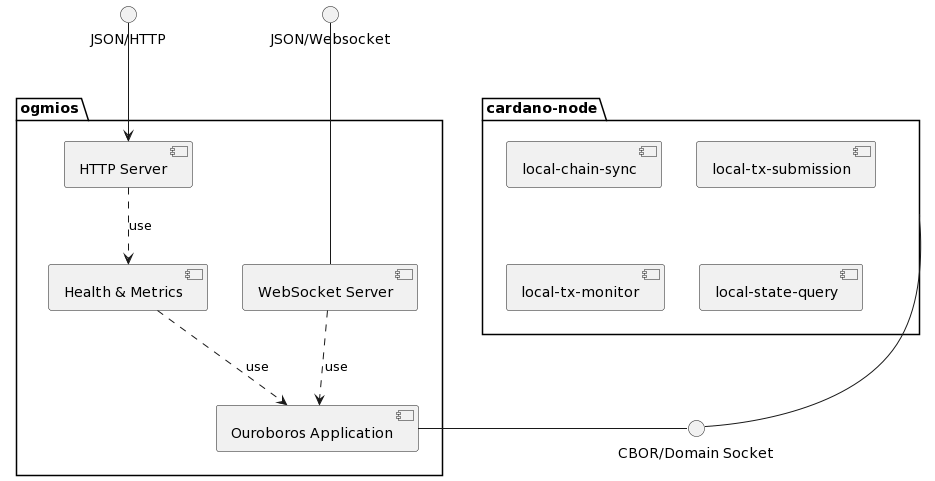Ogmios is a webserver which acts as a proxy for talking to a cardano-node. Upon request, it establishes a node-to-client connection with a Cardano node and forward messages from a client application to the node (and vice-versa). Ogmios aims to be as capable as a Cardano node (w.r.t. node-to-client protocols). Yet, since the internals are statically typed, new additions in the node (e.g. new queries) needs to be mapped correctly internally and, translated as JSON.
Ogmios does a little more than that, as it offers also some monitoring capabilities and embeds an HTTP server.
Ogmios is constructed as a three-layer Haskell cake, which aims at being a simple and maintainable architecture for Haskell applications. Effects are separated from the business logic, and the entire application is stitched together in a very thin layer.
Where top-level code lies, stitching together the various parts of the applications and exposing a high-level interface for building an executable.
Modules
^ ─── Ogmios.hs
| ├── Options.hs
Application | ├── Prelude.hs
v └── Version.hs
Contains data-structures and non-effectful code. Since Ogmios is mainly a codec translation layer, this is where most of the code (75%) lies. In particular, all the JSON encoders and decoders are defined here, as well as the JSON-WSP machinery behind all requests and responses.
Modules
^ ─── Data
| ├── EraTranslation.hs
| ├── Health.hs
| ├── Json.hs
| ├── Json
| │ ├── Prelude.hs
| │ ├── Orphans.hs
| │ ├── Query.hs
| │ ├── Byron.hs
| │ ├── Shelley.hs
| │ ├── Allegra.hs
| │ ├── Mary.hs
| │ ├── Alonzo.hs
Data | │ └── Babbage.hs
| ├── Metrics.hs
| ├── Protocol.hs
| └── Protocol
| ├── ChainSync.hs
| ├── StateQuery.hs
| ├── TxMonitor.hs
v └── TxSubmission.hs
Effectful code written leveraging Haskell's type-class as an effect system. This is where the client-side (where cardano-node acts as a server) implementation of ouroboros mini-protocols resides. This is also where we define the HTTP server and WebSocket server handlers.
Modules
^ ─── App
| ├── Health.hs
| ├── Metrics.hs
| ├── Configuration.hs
| ├── Protocol.hs
| ├── Protocol
| │ ├── ChainSync.hs
Logic | │ ├── StateQuery.hs
| │ ├── TxMonitor.hs
| │ └── TxSubmission.hs
| ├── Server.hs
| └── Server
| ├── Http.hs
| └── WebSocket.hs
v
A thin abstraction layer for I/O effects. This is based off io-sim with a few additions custom to Ogmios. The goal of these modules isn't to be a generic all-purpose I/O abstraction, but rather, something tailored to the project, that defines a clear interface for effects and that encapsulate their actual interpretation in one place. This allows for the rest of the code to remains mostly IO-free.
Modules
^ ─── Control
| ├── Exception.hs
| ├── MonadAsync.hs
| ├── MonadClock.hs
Effects | ├── MonadLog.hs
| ├── MonadMetrics.hs
| ├── MonadOuroboros.hs
| ├── MonadSTM.hs
v └── MonadWebSocket.hs

